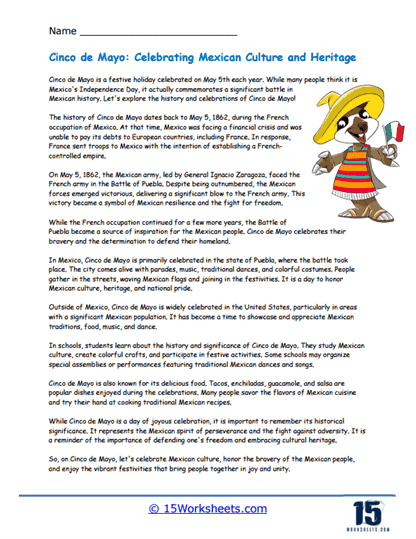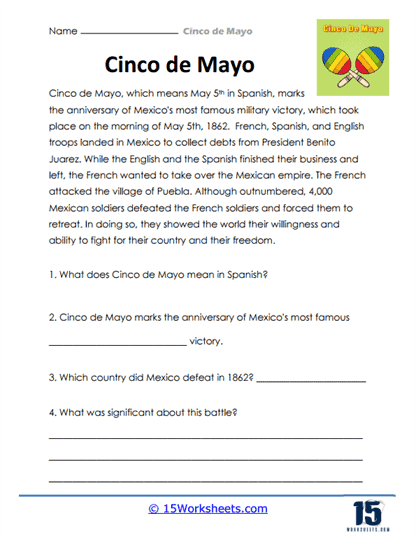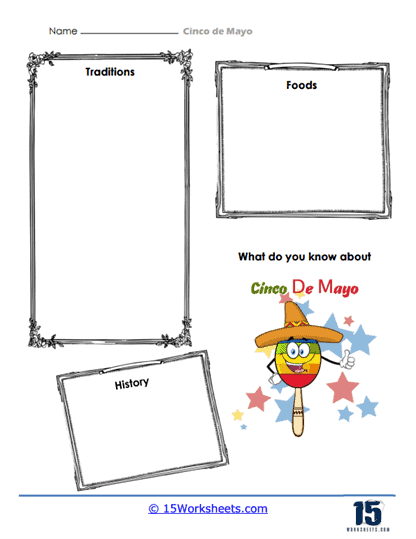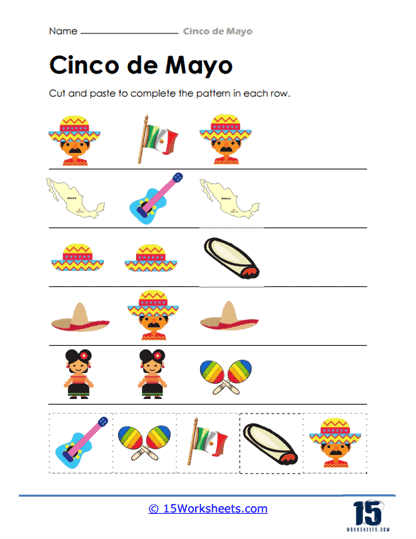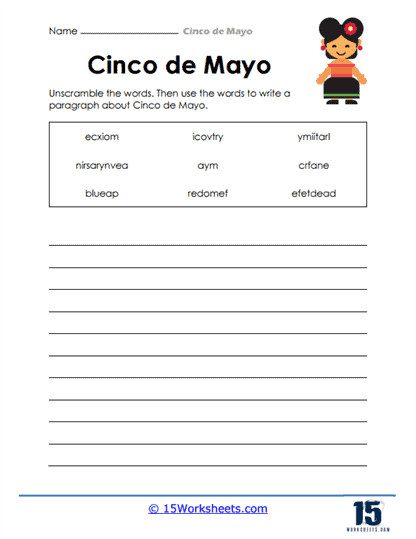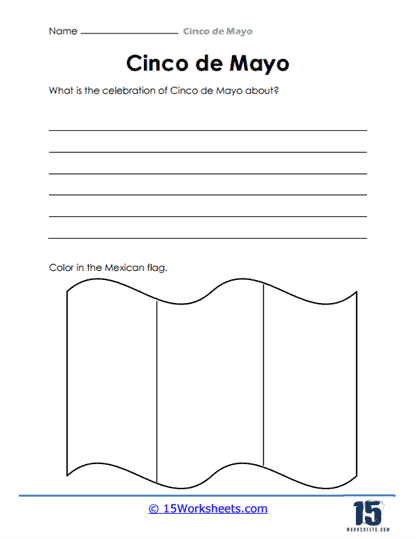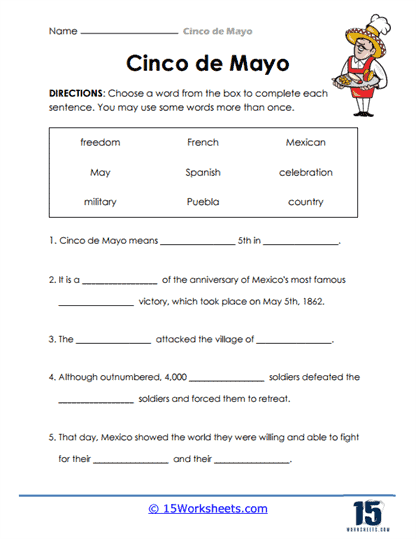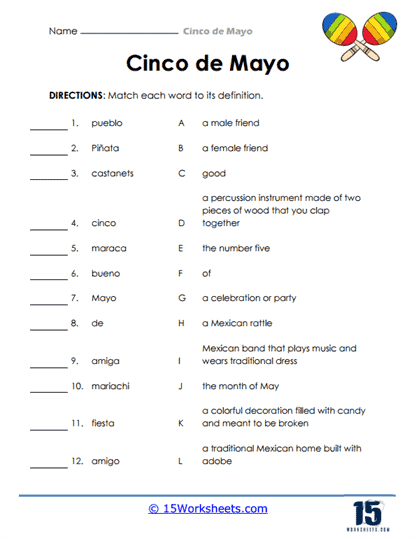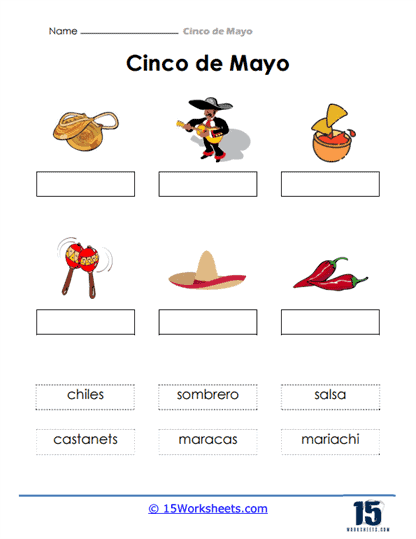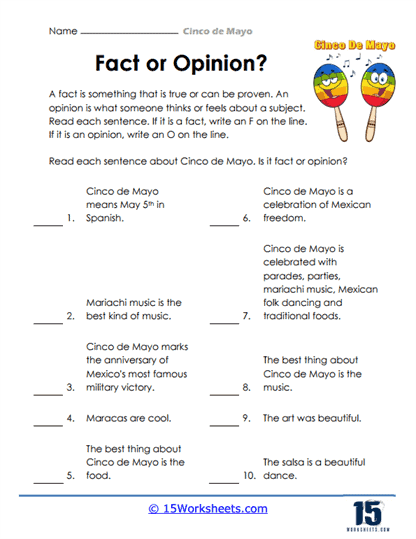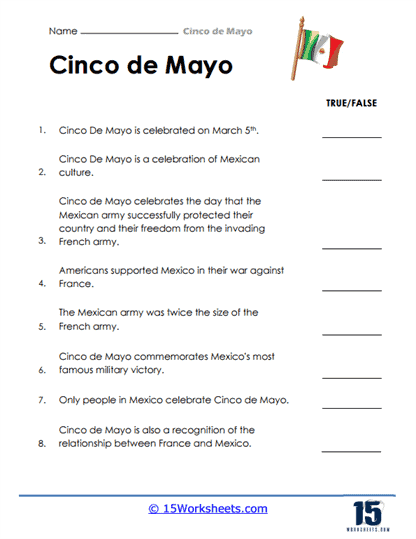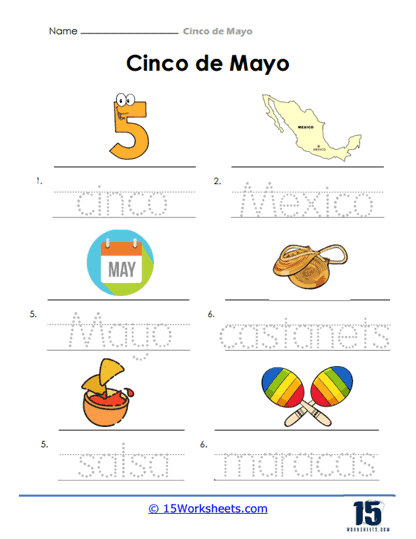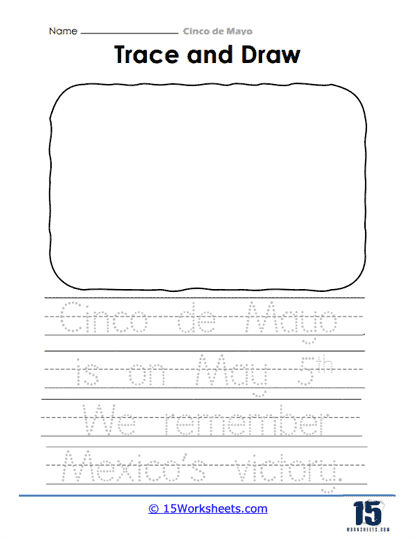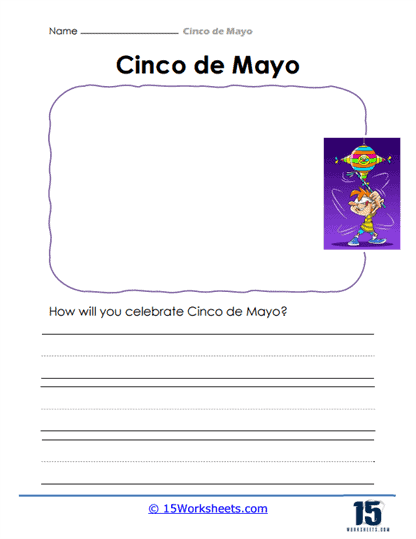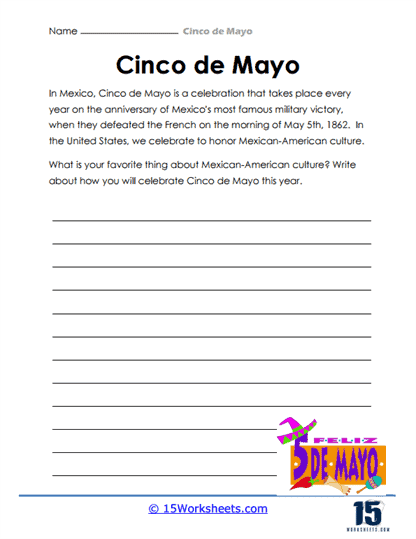Cinco de Mayo Worksheets
All About These 15 Worksheets
This comprehensive series of 15 worksheets serves as a dynamic and immersive educational tool, specially crafted to celebrate and explore the rich history, culture, and significance of Cinco de Mayo. While this holiday is often associated with festive parades, music, and colorful traditions, its roots go much deeper. The worksheets are designed to take students on a journey that unearths not only the historical context of Cinco de Mayo but also its broader cultural impact both within Mexico and across the globe.
Cinco de Mayo commemorates the Mexican army’s victory over the French forces at the Battle of Puebla on May 5, 1862. Often misunderstood as Mexico’s Independence Day, which is actually celebrated on September 16, Cinco de Mayo holds unique importance as a symbol of resilience and unity. By completing these worksheets, students will gain a nuanced understanding of the battle, the political tensions of the era, and the enduring symbolism of the holiday. This deeper comprehension fosters not only historical knowledge but also an appreciation for the values of courage, perseverance, and national pride that Cinco de Mayo represents.
Through engaging activities, these worksheets invite students to dig into the history, unraveling key events and figures that led to the holiday’s establishment. They’ll answer critical questions such as: Who were the key players involved in the Battle of Puebla? What were the stakes for Mexico at the time? And why did this event come to symbolize something far greater than a military triumph? By addressing these questions through the 5 W’s and 1 H (who, what, where, when, why, and how), students are challenged to think critically and craft their own descriptive paragraphs, developing not only historical insights but also their writing and analytical skills.
Yet, the value of this resource extends beyond history lessons. It brings the vibrant, celebratory aspects of Cinco de Mayo to life in the classroom. Students will partake in activities that showcase the rich cultural traditions of the holiday, such as music, food, and dance, which have become synonymous with Cinco de Mayo celebrations in Mexico and the United States. For instance, they may explore the energetic rhythms of mariachi music, the symbolism of colorful papel picado decorations, or the significance of traditional foods like mole poblano, further enhancing their cultural literacy.
Vocabulary-building exercises are woven throughout these worksheets, giving students the opportunity to learn and apply new words related to Cinco de Mayo. Terms such as mariachi, piñata, and charro (a traditional Mexican horseman) are introduced in context, allowing students to not only memorize their definitions but also understand their cultural significance. By expanding their vocabulary in this way, students strengthen their language skills while also gaining deeper insight into the cultural elements that shape the celebration of Cinco de Mayo.
In addition to factual knowledge, this series of worksheets offers opportunities for personal reflection. Through guided writing prompts, students are encouraged to express their thoughts on the importance of cultural diversity and inclusivity, contemplating how holidays like Cinco de Mayo can serve as a bridge between different cultures. This reflective component helps students internalize the lessons learned and apply them to their own lives, promoting empathy and cultural understanding.
Creativity is a key element of this educational resource as well. The worksheets feature a variety of hands-on activities, such as designing a Cinco de Mayo poster or creating their own papel picado banners, providing a fun and interactive way for students to engage with the holiday’s traditions. These creative tasks are not only enjoyable but also serve to deepen students’ connections to the cultural aspects of the celebration, fostering a sense of appreciation and respect for the customs of others.
Trivia quizzes, crossword puzzles, and word searches are also included to reinforce students’ knowledge in a fun and challenging way. These activities help solidify their understanding of key facts about Cinco de Mayo while testing their recall and critical thinking skills. In doing so, students not only retain important historical and cultural information but also develop their problem-solving abilities.
This series of worksheets is more than just an academic resource; it is a tool for fostering inclusivity, cultural appreciation, and personal growth. By engaging with the history and traditions of Cinco de Mayo, students are invited to become more thoughtful global citizens, recognizing the beauty of cultural diversity and the importance of celebrating different heritages. The worksheets promote a sense of unity in the classroom, encouraging students from all backgrounds to participate in and appreciate the shared celebration of an important cultural event.
What is Cinco de Mayo?
Cinco de Mayo, meaning “Fifth of May” in Spanish, is far more than just a date on the calendar. It commemorates a significant moment in Mexican history-the triumph of the Mexican army over French forces at the Battle of Puebla on May 5, 1862. While the holiday is sometimes misunderstood, particularly outside of Mexico, it stands as a symbol of Mexican resilience, national pride, and cultural identity. Yet, as we delve deeper into its origins and evolution, we discover that Cinco de Mayo has become much more than a historical commemoration; it has transformed into a vibrant celebration of Mexican culture and heritage, especially in the United States.
To understand the significance of Cinco de Mayo, we must first look back to the context in which the Battle of Puebla took place. In the 1860s, Mexico was in the throes of political and financial turmoil, having recently emerged from the Reform War, a civil conflict that left the country divided and economically drained. It was during this vulnerable period that the French Empire, under the rule of Napoleon III, sought to take advantage of Mexico’s weakened state by establishing a monarchy under the guise of collecting unpaid debts. The French forces, widely regarded as one of the most powerful military entities of the time, set their sights on Mexican territory, confident in their ability to impose their will.
On May 5, 1862, the French army, heavily armed and vastly superior in numbers, faced a modestly equipped Mexican force led by General Ignacio Zaragoza. What unfolded at the Battle of Puebla was nothing short of remarkable. Against overwhelming odds, the Mexican army achieved a stunning victory, halting the French advancement, at least temporarily. While the victory itself did not end the French occupation, it became a potent symbol of resistance and unity for the Mexican people. The battle demonstrated the resolve and courage of the Mexican forces, and it provided a much-needed boost to national morale during a dark time in the country’s history. To this day, the victory at Puebla stands as a point of pride for Mexicans, especially in the state of Puebla, where the battle occurred.
Though celebrated in Puebla and some regions of Mexico, Cinco de Mayo is not considered a major national holiday throughout the country. However, the significance of Cinco de Mayo has grown in the United States, where it has taken on new meaning as a celebration of Mexican-American culture. For many Mexican-Americans, Cinco de Mayo offers an opportunity to honor their heritage, share cultural traditions, and celebrate the contributions of the Mexican community to the broader American society. What began as a commemoration of a military victory has evolved into a larger, more festive occasion that highlights the richness and vibrancy of Mexican culture.
The holiday’s celebration in the United States is marked by parades, festivals, and events that bring together communities to celebrate Mexican music, dance, food, and traditions. Cities across the country-from Los Angeles to Chicago to Houston-host large Cinco de Mayo events featuring mariachi bands, traditional dances like the Jarabe Tapatío, and colorful displays of Mexican clothing and crafts. People also indulge in traditional Mexican cuisine, enjoying dishes like tacos, enchiladas, tamales, and popular beverages such as margaritas and Mexican beer. These celebrations provide a platform for cultural exchange, where people of all backgrounds come together to appreciate the heritage of their Mexican neighbors.
However, it is essential to clarify a common misconception: Cinco de Mayo is not Mexico’s Independence Day. Mexico’s Independence Day, celebrated on September 16th, marks the beginning of the Mexican War of Independence in 1810, a movement against Spanish colonial rule. While both holidays celebrate Mexican pride, they commemorate vastly different events in Mexican history. Understanding this distinction is crucial, especially when incorporating Cinco de Mayo into educational settings.
Celebrating Cinco de Mayo in the Classroom
For educators, Cinco de Mayo presents a unique opportunity to create an engaging, educational experience that goes beyond surface-level festivities. By integrating the holiday into lesson plans, teachers can introduce students to Mexican history, culture, and the broader themes of resilience and cultural pride. Below are some thoughtful and enriching ideas for incorporating Cinco de Mayo into the classroom in a meaningful way:
1. Discuss the Historical Significance
Begin by diving into the rich historical context behind Cinco de Mayo. Explore the story of the Battle of Puebla and the geopolitical climate that led to the French invasion. Encourage students to ask questions about why the French sought to establish a monarchy in Mexico and how the Mexican forces, despite their disadvantages, were able to secure victory. This historical exploration will not only build a deeper understanding of the holiday but also enhance students’ critical thinking skills as they reflect on the importance of perseverance and unity.
2. Introduce Mexican Cultural Traditions
Cinco de Mayo is a celebration of more than just a battle-it’s a gateway into Mexican culture. Teachers can immerse students in Mexican traditions by showcasing traditional music, such as mariachi and norteño, and discussing the role of dance, like the vibrant Jarabe Tapatío, in Mexican celebrations. Videos, guest speakers, or live demonstrations can bring these elements to life in the classroom, fostering a more interactive learning environment.
3. Art Projects Inspired by Mexican Culture
Engage students’ creativity by encouraging them to participate in Cinco de Mayo-themed art projects. Papel picado, a traditional Mexican paper-cutting art form, offers a fun and educational activity that highlights Mexican craftsmanship. Students could also design colorful sombreros, paint scenes from the Battle of Puebla, or recreate other cultural symbols like piñatas. These hands-on projects not only make learning enjoyable but also reinforce cultural appreciation through visual expression.
4. Exploring Mexican Cuisine
Food plays a central role in any cultural celebration, and Cinco de Mayo is no exception. Take this opportunity to discuss the importance of traditional Mexican cuisine, from tacos to churros. Depending on classroom resources, teachers could organize a small tasting event where students sample popular Mexican snacks or even try their hand at making simple recipes. This culinary exploration provides a multisensory experience that makes Mexican culture tangible and relatable.
5. Music and Dance as Cultural Expression
Introduce students to traditional Mexican music and dance by playing various styles in class. Mariachi music, with its distinctive trumpets, guitars, and violins, embodies the spirit of celebration, while the Mexican Hat Dance is both entertaining and culturally significant. Teachers can even go a step further by teaching students simple dance steps, allowing them to actively participate in the cultural traditions being studied.
6. Language Learning
Cinco de Mayo also presents an excellent opportunity for language learning. Teachers can introduce basic Spanish vocabulary related to the holiday and Mexican culture, helping students make connections between language and culture. By learning words like “fiesta,” “sombrero,” and “celebración,” students can develop a foundational understanding of Spanish while appreciating its role in Mexican heritage.
7. Classroom Displays of Mexican Culture
Transform the classroom into a vibrant celebration of Cinco de Mayo by decorating with Mexican flags, banners, sombreros, and maracas. Display students’ artwork or other projects, creating a visual reminder of the cultural richness they are studying. This environment fosters a sense of inclusivity and appreciation for Mexican traditions, making the learning experience immersive.
8. Storytelling Through Mexican Folklore
To further enrich the classroom experience, share stories or books that delve into Mexican history and folklore. These narratives can provide a deeper understanding of the cultural values and historical experiences that have shaped Mexican identity. Stories about heroes, legends, and folktales can spark students’ imaginations and inspire further exploration of Mexican culture.
9. Host a Mini-Fiesta
End the unit with a small classroom fiesta where students can showcase what they’ve learned about Cinco de Mayo. Play music, organize traditional games, and enjoy Mexican-inspired snacks as a way to celebrate the culmination of their learning. This final event not only reinforces the themes of the holiday but also brings the class together in a joyful, respectful celebration of Mexican culture.

